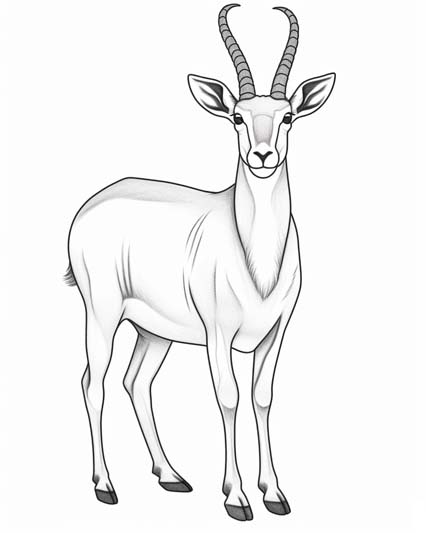Printable Coloring Pages
Antelope Coloring Pages
Adventure into the Savannah with our Antelope Coloring Pages
Hello, young artists and wildlife enthusiasts! Today, we're taking a journey to the vast savannas to explore one of the most agile and graceful creatures that roam these landscapes – the Antelope!
Antelopes are known for their swift movements and stunning horns, making them a captivating subject for your artistic expressions. Whether you are drawn to their elegant forms or the allure of the wild, our collection of Antelope Coloring Pages is sure to ignite your creativity and love for these fascinating animals.
We've carefully curated a variety of coloring pages to suit all tastes and skill levels. If you're a fan of cute and whimsical designs, our kawaii antelope pages will fill your heart with joy. These adorable illustrations capture the playful spirit of these creatures, perfect for letting your imagination run wild with colors.
For those who love precision and detail, our collection also includes realistic antelope coloring pages. These lifelike illustrations offer a closer look at the antelope's distinct features, providing a fantastic way to enhance your artistic skills while learning more about these magnificent creatures.
So, grab your favorite coloring tools and get ready to embark on a creative journey into the wild. Whether you prefer the cuteness of kawaii or the intricate details of realism, our Antelope Coloring Pages provide a delightful artistic adventure.
Realistic Antelope Coloring Pages:
Cute Antelope Coloring Pages:
Kawaii Antelope Coloring Pages:
Types of Antelope:
- Springbok (Antidorcas marsupialis): The Springbok is a medium-sized antelope found mainly in southern and southwestern Africa. They're known for their unique "pronking" behavior, where they leap into the air with an arched back and stiff legs.
- Impala (Aepyceros melampus): The Impala is a medium-sized antelope that inhabits the savannas and woodland areas of eastern and southern Africa. They are known for their agility and can leap distances of up to 10 meters and heights of about 3 meters.
- Gazelle (Gazella): Gazelles are small to medium-sized antelopes found in the grasslands and deserts of Africa and Asia. They are known for their speed and grace, able to maintain high speeds for extended periods to evade predators.
- Wildebeest (Connochaetes): Also known as gnus, Wildebeests are large antelopes that live in the plains and open woodlands of Africa, particularly the Serengeti in Tanzania and Kenya. They are known for their annual migration, one of the world's most spectacular wildlife events.
- Kudu (Tragelaphus strepsiceros): The Kudu is a large antelope found in the bushlands of eastern and southern Africa. They are known for their long, spiral horns and beautiful striped bodies.
- Sable Antelope (Hippotragus niger): The Sable Antelope is a large, robust antelope found in the savannah woodlands of eastern and southern Africa. They are known for their impressive ringed horns, which can reach lengths of up to 165 cm.
- Gerenuk (Litocranius walleri): The Gerenuk, also known as the giraffe gazelle, is a long-necked antelope that inhabits the dry bushy scrub and steppe in East Africa. They are known for their unique ability to stand on their hind legs and stretch their long necks to reach leaves and shoots higher up in the trees.
- Oryx (Oryx): Oryxes are large antelopes that live in the arid regions of Africa and the Arabian Peninsula. They are known for their long, straight horns and a distinctive shoulder bump, and their ability to survive in extremely hot, harsh environments.
- Roan Antelope (Hippotragus equinus): The Roan Antelope is a large, horse-like antelope found in the savannas of Sub-Saharan Africa. They are known for their reddish-brown coat and long, pointed ears.
- Dik-Dik (Madoqua): The Dik-Dik is one of the smallest antelopes and is found in the bushlands of eastern and southern Africa. They are known for their monogamous habits and the distinctive 'dik-dik' sound they make when threatened, which is how they got their name.
The Pronghorn, often referred to as the "American Antelope," is native to North America. However, it's important to note that while the Pronghorn (Antilocapra americana) is often colloquially referred to as an antelope, it is not a true antelope in the biological sense. The Pronghorn is the only surviving member of the Antilocapridae family, whereas true antelopes belong to the Bovidae family.
The Pronghorn is found in western and central North America, ranging from southern Canada to northern Mexico. It is known for its impressive speed (it is the second-fastest land animal, next to the cheetah) and its unique branching horns, which have a forward-facing prong, hence the name "Pronghorn".




















